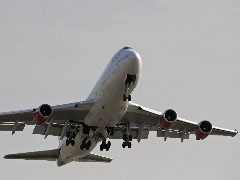Features
Biofuels take flight
Date: 2008-05-30 15:51:11.0
Author: Jon Evans

Virgin Atlantic's biofuel-powered 747 takes off.
Photo courtesy of Virgin Atlantic.
On 24 February 2008, Virgin Atlantic became the first airline to embrace biofuels, when one of its 747 jumbo jets flew from London to Amsterdam on a mixture of kerosene and a nut oil-derived biofuel.
Following in formation close behind, however, will be Air New Zealand and Continental Airlines, both of which have announced plans to carry out test flights with biofuels. In addition, on 1 February 2008, the European aircraft manufacturer Airbus flew one of its A380 aircraft on a synthetic fuel derived from natural gas, with the ultimate aim of utilising biofuels in the future.
The aviation industry's new-found infatuation with biofuels is being driven by the same factors that have encouraged the use of biofuels in motor vehicles: the high price of oil and the desire to reduce carbon emissions. But, unfortunately, the aviation industry can't just utilise the biofuels that have already been developed for the automotive industry, as both ethanol and biodiesel do not have the necessary properties.
Based on kerosene, current jet fuel possesses a fairly high energy density and is able to operate at the low temperatures that exist at high altitudes. In contrast, although biodiesel is reasonably similar to jet fuel, it still has an energy density that is 25% lower and is apt to freeze at low temperatures. This means that it clearly can't be used as a direct replacement for kerosene, which is what the aviation industry would ideally like from a biofuel.
However, a number of companies are currently developing refined versions of biodiesel that are more closely able to match the properties of jet fuel. These are collectively known as biojet.
The biojet fuel used by the Virgin Atlantic 747 was produced by the US biofuel developer Imperium Renewables from oil derived from coconuts and the Brazilian babassu nut. It was blended with standard kerosene at a concentration of just 20%, although ground tests indicate that it could be blended at concentrations of up to 40%.
Other companies are looking to produce biojet fuels that can replace kerosene completely. On example is UOP, the energy technology subsidiary of the US industrial conglomerate Honeywell, which is attempting to develop a biojet fuel based on its ‘green diesel' production technology.
Whereas biodiesel is conventionally produced from oils and fats via transesterification reactions, UOP's green diesel process, which it developed with the Italian energy company Eni, involves reacting the oils and fats with hydrogen. This hydroprocessing produces a biodiesel that is virtually indistinguishable from standard diesel and a similar process should be able to produce a biojet with exactly the same properties as standard jet fuel.
In June 2007, UOP received almost $7 million from the US Defense Advanced Research Projects Agency to help develop such a biojet fuel for military aircraft. Then, in May 2008, it announced the formation of a partnership with Airbus and others to develop a similar biojet fuel for commercial aircraft.
A range of other approaches are also being investigated. The US synthetic fuel company Syntroleum has developed a process based on the Fischer-Tropsch reaction that can produce synthetic jet fuel from vegetable oils, fats and greases. In 2007, Syntroleum established a joint venture, called Dynamic Fuels, with US meat processor Tyson Foods to convert low grade, inedible fats and greases into synthetic diesel and jet fuel. Dynamic Fuels is currently building a 75 million gallons a year plant to produce these synthetic fuels in Geismar, Louisiana, which it hopes will be completed in 2010.
Using genetically-engineered micro-organisms, the US biotechnology company Amyris is developing processes for producing petrol, diesel and jet fuel from a range of different feedstocks. In April 2008, it announced plans to produce all these fuels from sugarcane, in conjunction with the Brazilian ethanol distributor Crystalsev.
So it looks as though the sky could soon be full of biofuel-powered aircraft. Virgin Atlantic's president, Sir Richard Branson, certainly thinks so: ‘This pioneering flight will enable those of us who are serious about reducing our carbon emissions to go on developing the fuels of the future, fuels which will power our aircraft in the years ahead.'
The views represented here are solely those of the author and do not necessarily represent those of John Wiley and Sons, Ltd. or of the SCI.
Displaying 7 keywords used to tag this article:
- GHG
- climate change
- corn
- rice
- fossil fuels
- soybean
- environment
